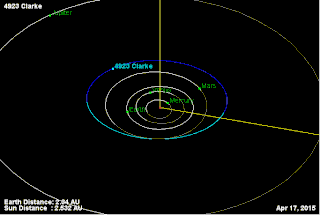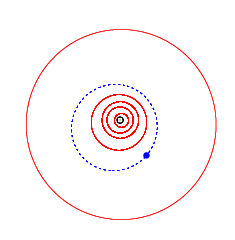Related Research Articles

4923 Clarke, provisional designation 1981 EO27, is a stony background asteroid from the inner regions of the asteroid belt, approximately 3.5 kilometers (2.2 miles) in diameter. It was discovered on 2 March 1981, by American astronomer Schelte Bus at the Siding Spring Observatory in Australia. The spheroidal S-type asteroid has a rotation period of 3.14 hours. It was named after British science fiction writer Arthur C. Clarke. On the same night, Schelte Bus also discovered 5020 Asimov.
2006 Polonskaya (provisional designation: 1973 SB3) is a stony Flora asteroid and asynchronous binary system from the inner regions of the asteroid belt, approximately 5 kilometers (3.1 miles) in diameter. It was discovered on 22 September 1973, by Soviet astronomer Nikolai Chernykh at the Crimean Astrophysical Observatory in Nauchnij, on the Crimean peninsula, and later named after Ukrainian astronomer Elena Kazimirtchak-Polonskaïa. Its one-kilometer-sized satellite was discovered by an international collaboration of astronomers in November 2005.
3673 Levy, provisional designation 1985 QS, is a binary Flora asteroid from the inner regions of the asteroid belt, approximately 6 kilometers in diameter. It was discovered on 22 August 1985, by American astronomer Edward Bowell at Lowell's Anderson Mesa Station near Flagstaff, Arizona, United States. The asteroid was named after Canadian astronomer David H. Levy.

(9948) 1990 QB2 (provisional designation 1990 QB2) is a stony Nysian asteroid from the inner region of the asteroid belt, approximately 3.4 kilometers (2.1 miles) in diameter. It was discovered on 22 August 1990, by American astronomer Henry Holt at the Palomar Observatory in California. The likely elongated S-type asteroid has a rotation period of 3.53 hours. This asteroid has not been named.
6398 Timhunter, provisional designation 1991 CD1, is a stony Phocaea asteroid from the inner regions of the asteroid belt, approximately 5.5 kilometers in diameter. It was discovered on 10 February 1991, by American astronomer couple Carolyn and Eugene Shoemaker, in collaboration with Canadian astronomer David H. Levy at Palomar Observatory in California, United States. It was named for American amateur astronomer Tim Hunter.
3067 Akhmatova, provisional designation 1982 TE2, is a stony Flora asteroid from the inner regions of the asteroid belt, approximately 6 kilometers in diameter.
6084 Bascom, provisional designation 1985 CT, is a binary Phocaea asteroid from the inner regions of the asteroid belt, approximately 6.3 kilometers in diameter. It was discovered on 12 February 1985, by American astronomer couple Carolyn and Eugene Shoemaker at Palomar Observatory in California. It is named after American geologist Florence Bascom. Its satellite measures approximately 2.3 kilometers and has an orbital period of 43.51 hours.
29292 Conniewalker (provisional designation 1993 KZ1) is a bright, stony Phocaea asteroid and slow tumbler from the inner regions of the asteroid belt, approximately 4.6 kilometers in diameter. It was discovered on 24 May 1993, by American astronomer Carolyn Shoemaker and Canadian astronomer David Levy at the Palomar Observatory in California, United States.
4340 Dence, provisional designation 1986 JZ, is a background or Phocaea asteroid from the inner regions of the asteroid belt, approximately 8 kilometers in diameter. It was discovered on 4 May 1986, by American astronomer Carolyn Shoemaker at the Palomar Observatory in California. The S-type asteroid has a rotation period of 7.5 hours. It was named after Canadian geologist Michael R. Dence.
1806 Derice, provisional designation 1971 LC, is a stony Flora asteroid from the inner regions of the asteroid belt, approximately 10 kilometers in diameter. Discovered on 13 June 1971, at the Bickley site of the Perth Observatory in Western Australia, it was the first discovery of a minor planet ever made in Oceania. The asteroid was named after the wife of Dennis Harwood, staff member at Bickley.
2648 Owa, provisional designation 1980 VJ, is a background asteroid from the Flora region of the inner asteroid belt, approximately 6 kilometers in diameter. It was discovered on 8 November 1980, by American astronomer Edward Bowell at the Anderson Mesa Station near Flagstaff, Arizona, in the United States. The presumably S-type asteroid has a rotation period of 3.56 hours. It was named for the word "rock" in the Native American Hopi language.
1990 Pilcher, provisional designation 1956 EE, is a stony background asteroid from the Florian region of the inner asteroid belt, approximately 7 kilometers in diameter. It was discovered on 9 March 1956, by German astronomer Karl Reinmuth at the Heidelberg-Königstuhl State Observatory in Heidelberg, Germany. In 1982, it was named by the MPC for American physicist and photometrist Frederick Pilcher. The S-type asteroid has a short rotation period of 2.8 hours.
6615 Plutarchos, provisional designation 9512 P-L, is a Florian asteroid and suspected binary from the inner regions of the asteroid belt, approximately 3.1 kilometers in diameter. Discovered during the Palomar–Leiden survey in 1960, the asteroid was later named after the Greek philosopher Plutarch. Its minor-planet moon was discovered in 2007.
1979 Sakharov, provisionally designated 2006 P-L, is a stony Vestian asteroid from the inner regions of the asteroid belt, approximately 4.5 kilometers in diameter. It was discovered during the Palomar–Leiden survey in 1960, and named after Russian physicist Andrei Sakharov.
6376 Schamp, provisional designation 1987 KD1, is a stony background asteroid from the central regions of the asteroid belt, approximately 8 kilometers (5 miles) in diameter. It was discovered on 29 May 1987, by American astronomer couple Carolyn and Eugene Shoemaker at the Palomar Observatory in California. The S-type asteroid has a rotation period of 6.6 hours. It was named after Larry and Becky Schamp who took care of the Shoemaker family after Eugene's fatal car accident in Australia.
4760 Jia-xiang, provisional designation 1981 GN1, is a background asteroid from the inner regions of the asteroid belt, approximately 5 kilometers (3 miles) in diameter. It was discovered on 1 April 1981, by astronomers at Harvard University's Oak Ridge Observatory in Massachusetts, United States. The presumed stony S-type asteroid was named after Chinese astronomer Zhang Jiaxiang. It has a rotation period of 14.96 hours.
1530 Rantaseppä, provisional designation 1938 SG, is a stony Florian asteroid from the inner regions of the asteroid belt, approximately 5 kilometers in diameter. Discovered by Yrjö Väisälä at Turku Observatory in 1938, it was later named after Finnish astronomer Hilkka Rantaseppä-Helenius.
2195 Tengström, provisional designation 1941 SP1, is a stony Florian asteroid from the inner regions of the asteroid belt, approximately 8 kilometers in diameter. It was discovered on 27 September 1941, by Finnish astronomer Liisi Oterma at Turku Observatory in Southwest Finland, and named for Swedish geodesist Erik Tengström.
3982 Kastelʹ, provisional designation 1984 JP1, is a Florian asteroid and a suspected binary system from the inner regions of the asteroid belt, approximately 6.9 kilometers in diameter.
(6265) 1985 TW3 (provisional designation 1985 TW3) is a background asteroid and binary system from the inner regions of the asteroid belt. It was discovered on 11 October 1985, by astronomer by T. F. Fric and Richard Gilbrech at the Palomar Observatory in California. It is the only minor-planet discovery for these two astronomers. The stony L-type asteroid measures approximately 5 kilometers (3.1 miles) in diameter and has a rotation period of 2.7 hours. Its 1.2-kilometer sized minor-planet moon was discovered in July 2007 and announced the following month.
References
- 1 2 3 4 "JPL Small-Body Database Browser: 4364 Shkodrov (1978 VV5)" (2017-11-27 last obs.). Jet Propulsion Laboratory . Retrieved 19 January 2018.
- 1 2 3 4 "4364 Shkodrov (1978 VV5)". Minor Planet Center. Retrieved 19 January 2018.
- 1 2 "Small Bodies Data Ferret". Nesvorny HCM Asteroid Families V3.0. Archived from the original on 2 August 2017. Retrieved 19 January 2018.
- 1 2 "Asteroid 4364 Shkodrov – Proper Elements". AstDyS-2, Asteroids – Dynamic Site. Retrieved 29 October 2019.
- 1 2 3 4 5 6 7 8 9 "LCDB Data for (4364) Shkodrov". Asteroid Lightcurve Database (LCDB). Retrieved 19 January 2018.
- 1 2 3 4 Nugent, C. R.; Mainzer, A.; Bauer, J.; Cutri, R. M.; Kramer, E. A.; Grav, T.; et al. (September 2016). "NEOWISE Reactivation Mission Year Two: Asteroid Diameters and Albedos". The Astronomical Journal. 152 (3): 12. arXiv: 1606.08923 . Bibcode:2016AJ....152...63N. doi: 10.3847/0004-6256/152/3/63 .
- 1 2 3 4 Waszczak, Adam; Chang, Chan-Kao; Ofek, Eran O.; Laher, Russ; Masci, Frank; Levitan, David; et al. (September 2015). "Asteroid Light Curves from the Palomar Transient Factory Survey: Rotation Periods and Phase Functions from Sparse Photometry". The Astronomical Journal. 150 (3): 35. arXiv: 1504.04041 . Bibcode:2015AJ....150...75W. doi:10.1088/0004-6256/150/3/75. S2CID 8342929 . Retrieved 19 January 2018.
- ↑ Veres, Peter; Jedicke, Robert; Fitzsimmons, Alan; Denneau, Larry; Granvik, Mikael; Bolin, Bryce; et al. (November 2015). "Absolute magnitudes and slope parameters for 250,000 asteroids observed by Pan-STARRS PS1 - Preliminary results". Icarus. 261: 34–47. arXiv: 1506.00762 . Bibcode:2015Icar..261...34V. doi:10.1016/j.icarus.2015.08.007. S2CID 53493339 . Retrieved 19 January 2018.
- ↑ "MPC/MPO/MPS Archive". Minor Planet Center. Retrieved 19 January 2018.